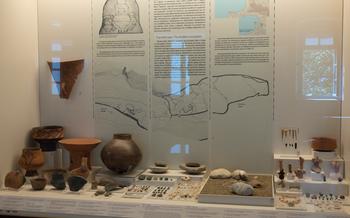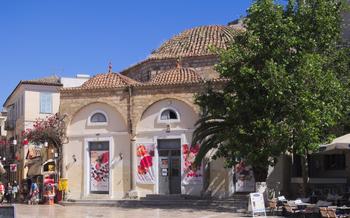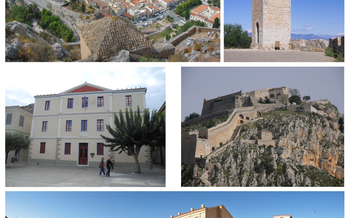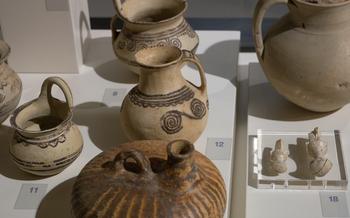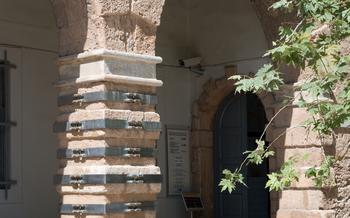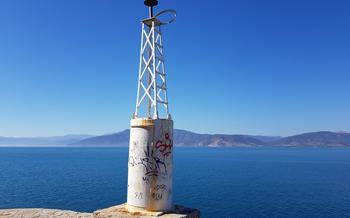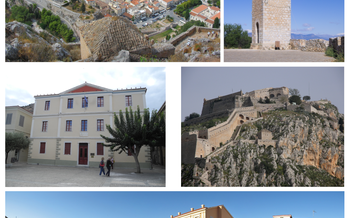
Archaeological Site of Tiryns
- A Journey Through Time in Tiryns:
- Unveiling the Ancient Ruins
- Exploring the Cyclopean Walls
- The Palace of Tiryns: A Glimpse into Ancient Splendor
- Water Management Systems
- Exploring the Lower Town
- Excavations and Archaeological Findings
- Mythology and Legends of Tiryns
- Breathtaking Views
- Visiting Information
- Guided Tours and Audio Guides
- Combining History with Nature:
- Local Cuisine and Hospitality:
- Other Historical Sites in the Area
- Insider Tip: Unveiling Hidden Gems and Capturing Unique Perspectives
A Journey Through Time in Tiryns:
In the heart of the Peloponnese, Greece, lies the ancient city of Tiryns, a testament to the ingenuity and power of the Mycenaean civilization. Its history is intertwined with legends and myths, making it a captivating destination for history buffs and mythology enthusiasts alike.
Tiryns' significance in ancient Greece stemmed from its strategic location, controlling the passage between the Argolic Gulf and the inland regions. The city's impressive fortifications and well-preserved ruins offer a glimpse into the grandeur of the Mycenaean era, making it a must-visit destination for anyone interested in ancient history and archaeology.
Unveiling the Ancient Ruins
As you step into the archaeological site of Tiryns, you'll be greeted by an array of impressive ruins that speak volumes about the city's glorious past. The most prominent feature is the Lower Citadel, a fortified enclosure that once housed the royal palace and other important structures. Its massive walls, constructed using the renowned Cyclopean technique, stand as a testament to the architectural prowess of the ancient builders.
Within the Lower Citadel, you'll find the remains of the impressive palace, which once served as the residence of Tiryns' rulers. The grand entrance, adorned with intricate carvings, leads to a series of chambers and storerooms, offering a glimpse into the opulent lifestyle of the city's elite. The throne room, with its elevated platform and surrounding columns, evokes a sense of power and authority.
Adjacent to the Lower Citadel lies the Upper Citadel, a smaller enclosure that served as a refuge during times of danger. Here, you'll find the remains of a temple dedicated to the goddess Hera, as well as several defensive structures, including towers and ramparts.
Throughout the site, you'll encounter various other ruins, including houses, workshops, and public buildings. These remnants provide valuable insights into the daily lives and activities of Tiryns' inhabitants. The well-preserved water management system, with its cisterns and aqueducts, highlights the city's advanced engineering skills and the importance of water in ancient times.
Exploring the Cyclopean Walls
The Cyclopean walls of Tiryns are a remarkable feat of ancient engineering and construction. These massive fortifications, made of enormous blocks of stone, some weighing up to several tons, stand as a testament to the ingenuity and skill of the ancient builders. The walls are approximately 6 meters thick and reach a height of up to 15 meters in some places. Their construction involved stacking these massive blocks without the use of mortar or other binding materials, relying solely on gravity and precision to create a stable and impenetrable barrier.
The walls feature a unique construction technique known as "cyclopean masonry," characterized by the use of large, irregularly shaped stones. These stones were carefully selected and fitted together to form a solid and durable structure. The walls are also notable for their inward slope, which provided additional stability and made them difficult to scale.
Theories abound regarding the builders of these impressive walls. Some believe they were constructed by the legendary Cyclopes, gigantic one-eyed creatures from Greek mythology, while others attribute their construction to the skilled hands of the Mycenaean civilization. Regardless of their origin, the Cyclopean walls of Tiryns stand as a testament to the advanced engineering and architectural prowess of the ancient Greeks, and continue to captivate visitors with their grandeur and mystery.
The Palace of Tiryns: A Glimpse into Ancient Splendor
Within the walls of Tiryns lies the grandest structure of the ancient city: the royal palace. This sprawling complex, once the seat of power and opulence, offers visitors a glimpse into the lives of Tiryns' rulers. As you step through the monumental entrance, you'll be greeted by a majestic courtyard, leading to the heart of the palace. The throne room, with its imposing throne and intricate decorations, commands attention. Here, the kings of Tiryns once held court, made decisions, and received their subjects. Adjoining the throne room are various chambers and storerooms, each revealing artifacts that tell tales of the palace's grandeur. From elegant pottery and jewelry to imported goods from distant lands, these treasures showcase the wealth and sophistication of Tiryns' royal court.
Water Management Systems
The ancient city of Tiryns possessed an ingenious water management system that ensured a reliable water supply for its inhabitants. Large, underground cisterns were strategically placed within the city walls to collect and store rainwater. These cisterns were carefully constructed using waterproof materials and featured intricate drainage channels to prevent leakage.
Additionally, a sophisticated network of aqueducts was built to channel water from nearby springs and rivers into the city. These aqueducts were meticulously engineered with a slight gradient to ensure a continuous flow of water. The water management system not only provided a vital resource for daily life but also played a crucial role in the defense of the city during sieges.
By controlling the water supply, the people of Tiryns could effectively limit the enemy's access to water and maintain their resilience during prolonged conflicts. The sophisticated water management system at Tiryns stands as a testament to the ingenuity and foresight of its ancient builders, who recognized the importance of water as a strategic resource.
Exploring the Lower Town
Venturing beyond the imposing citadel walls, visitors can explore the remains of the lower town of Tiryns, where the ordinary citizens of this ancient city once lived and worked. Here, one can wander amid the ruins of houses, workshops, and public buildings, gaining insights into the everyday lives of Tiryns' inhabitants.
The lower town was a bustling hub of activity, where locals engaged in various trades and crafts. Workshops for pottery, metalworking, and textile production have been unearthed, providing glimpses into the diverse skills possessed by Tiryns' artisans. Public buildings, such as a small theater and a market, served as gathering places for the community.
Walking through the lower town, one can't help but imagine the sights and sounds of daily life in ancient Tiryns. The narrow, winding streets would have been filled with people going about their daily routines, buying and selling goods, or engaging in lively conversations. The theater would have echoed with laughter and applause as audiences enjoyed performances, while the market would have been a cacophony of voices and the clinking of coins.
Exploring the lower town is an opportunity to connect with the human side of Tiryns' history, beyond the grandeur of its palaces and fortifications. It's a chance to imagine the lives of ordinary people who contributed to the city's prosperity and vibrancy, making it one of the most significant Bronze Age centers in Greece.
Excavations and Archaeological Findings
The uncovering of the ancient city of Tiryns is largely attributed to the meticulous excavations conducted by renowned archaeologists. In the late 19th century, Heinrich Schliemann, known for his work at Troy, turned his attention to Tiryns. His excavations unearthed significant portions of the site, including the impressive Cyclopean walls and the remains of the royal palace.
In the 20th century, systematic excavations were carried out by the Greek Archaeological Service, led by renowned archaeologists such as Christos Tsountas and Spyridon Marinatos. These excavations brought to light additional structures and artifacts, shedding more light on the city's layout, daily life, and cultural significance.
Among the notable discoveries made at Tiryns are numerous pottery fragments, tools, and weapons, providing valuable insights into the material culture of the ancient inhabitants. Additionally, the excavation of the Lower Town revealed residential areas, workshops, and public buildings, offering a glimpse into the everyday lives of Tiryns' citizens.
Ongoing research and conservation efforts continue to contribute to our understanding of Tiryns. Archaeological excavations, restoration projects, and the establishment of an on-site museum have helped preserve and showcase the remarkable legacy of this ancient city for future generations to appreciate and study.
Mythology and Legends of Tiryns
Tiryns is deeply entwined with the rich tapestry of Greek mythology and legends. The city's association with the mythical hero Hercules is particularly captivating. According to legend, Hercules was born in Tiryns and performed many of his legendary labors in the surrounding region. These tales of strength and courage have immortalized the city's name in the annals of Greek mythology.
Another intriguing legend revolves around the founding of Tiryns. It is said that the city was established by Proitos, the twin brother of Acrisius, the king of Argos. Proitos was driven out of Argos by his brother and sought refuge in Tiryns, where he built a magnificent citadel. These myths not only add to the allure of the site but also provide a glimpse into the cultural and religious beliefs of ancient Greece.
Breathtaking Views
The citadel of Tiryns offers panoramic vistas that are nothing short of breathtaking. From its elevated position, visitors can feast their eyes on the picturesque surrounding countryside, the shimmering waters of the Argolic Gulf, and the distant mountains. The views from Tiryns are so stunning that they have been immortalized in countless paintings and photographs.
One of the best times to visit Tiryns is during sunset, when the sky is ablaze with warm colors and the landscape is bathed in a golden glow. The views from the citadel at this time of day are truly magical, and visitors can capture some truly unforgettable photographs.
For photography enthusiasts, Tiryns is a paradise. The ancient ruins, set against the backdrop of the stunning natural scenery, provide endless opportunities for capturing unique and beautiful images. Whether you're a professional photographer or simply someone who enjoys taking snapshots, you'll find plenty of inspiration at Tiryns.
Visiting Information
Planning a visit to the Archaeological Site of Tiryns is a rewarding experience for history enthusiasts and travelers alike. Here are some essential details to ensure a smooth and enjoyable visit:
-
Opening Hours: Tiryns is open to the public daily, except for Mondays. Visiting hours vary depending on the season and can be found on the official website or at the entrance to the site.
-
Admission Fees: There is an admission fee for entry into the site, which is typically a few euros. Reduced rates or free admission may be available for students, seniors, or disabled visitors.
-
Best Time to Visit: To avoid the crowds and enjoy a more relaxed exploration, plan your visit during the shoulder seasons (spring or autumn). Summer months can be hot and crowded, while winters can be chilly, so dress accordingly.
-
What to Bring: Comfortable footwear is essential for navigating the uneven terrain and climbing stairs. Bring sunscreen, a hat, and sunglasses for protection from the sun. A camera is also recommended to capture the stunning views and historical remains.
-
Accessibility: The site is generally accessible to visitors with limited mobility, as there are ramps and paved paths throughout. However, some areas, such as the upper levels of the citadel, may be difficult to access for wheelchair users.
Guided Tours and Audio Guides
Enhance your experience at the Archaeological Site of Tiryns by opting for a guided tour or renting an audio guide. Knowledgeable guides can provide valuable insights into the history, architecture, and significance of Tiryns. They can bring the ancient ruins to life with their captivating stories and explanations, helping you understand the site's importance in the context of ancient Greece.
Audio guides offer a convenient and self-paced alternative, allowing you to explore the site at your own rhythm. These guides typically provide detailed information about each section and structure, allowing you to learn about Tiryns' history and significance as you wander through the ruins.
Guided tours are available in various languages, including English, French, German, and Italian. Prices vary depending on the group size and the duration of the tour. Audio guides can be rented at the site's entrance for a small fee.
Whether you choose a guided tour or an audio guide, these resources can greatly enhance your understanding and appreciation of the Archaeological Site of Tiryns.
Combining History with Nature:
While delving into the rich history of Tiryns, don't miss the chance to explore the natural beauty that surrounds this ancient site. Just a stone's throw away, you'll find pristine beaches, inviting hiking trails, and breathtaking viewpoints that offer panoramic vistas of the region.
For a refreshing dip in the crystal-clear waters of the Aegean Sea, head to the nearby beaches of Tolo or Kastraki. Bask in the warm Mediterranean sun, build sandcastles with the kids, or simply relax and soak up the tranquil atmosphere.
If you're an avid hiker, lace up your boots and embark on one of the many trails that crisscross the surrounding hills. Admire the diverse flora and fauna, breathe in the fresh air, and enjoy the panoramic views that unfold with every step.
Don't forget your camera, as the region offers countless photo opportunities. Capture the majestic ruins of Tiryns against the backdrop of the shimmering sea, or frame the picturesque villages nestled among lush olive groves.
To make the most of your visit, consider renting a car, which will give you the freedom to explore the region at your own pace. Alternatively, join a guided tour that will take you to multiple historical sites in the area, ensuring you don't miss any hidden gems.
Local Cuisine and Hospitality:
When visiting Tiryns, you'll have the chance to savor the delectable flavors of traditional Greek cuisine at nearby tavernas and restaurants. Immerse yourself in the local culinary scene by indulging in freshly caught seafood, delectable regional specialties, and the finest local wines. The warm hospitality and friendliness of the local people will make your dining experience even more enjoyable. Whether you're looking for a quick bite or a leisurely meal, you'll find a welcoming atmosphere and delicious food that will satisfy your cravings.
Other Historical Sites in the Area
Nafplio is a treasure trove of ancient history, with several significant archaeological sites located in close proximity to Tiryns. The ancient city of Mycenae, renowned for its impressive fortifications and the legendary Lion Gate, is just a short drive away. Discover the royal tombs, Cyclopean walls, and the Palace of Agamemnon, where the mythical king once ruled.
Epidaurus, another must-see destination, is home to the remarkably well-preserved ancient theater. Marvel at its exceptional acoustics and imagine the grand performances that took place in this magnificent setting. The Sanctuary of Asclepius, dedicated to the god of healing, offers further insight into ancient Greek medical practices.
To the west, the ruins of ancient Corinth beckon. Explore the remains of the Temple of Apollo, the Agora, and the Bema, where the Apostle Paul delivered his famous speech. Corinth's rich history as a commercial and cultural center is evident in its well-preserved monuments.
To make the most of your visit to these historical sites, consider renting a car for the day. This will allow you the flexibility to set your own pace and explore at your leisure. Alternatively, guided tours are available from Nafplio, providing transportation and expert commentary.
Insider Tip: Unveiling Hidden Gems and Capturing Unique Perspectives
As you wander through the ruins of Tiryns, keep an eye out for hidden corners and lesser-known spots that offer unique perspectives and photo opportunities. One such gem is the secluded chamber known as the "Treasury of Atreus." This underground chamber, believed to have been used for storing valuables, features an impressive corbelled dome and exudes an aura of mystery.
For an unforgettable photo, climb to the highest point of the citadel and capture the breathtaking panorama that unfolds before you. The sweeping views encompass the surrounding countryside, the shimmering Argolic Gulf, and the distant mountains, creating a picture-perfect moment.
Finally, to avoid the crowds and experience a more tranquil atmosphere, consider visiting Tiryns early in the morning or late in the afternoon when the site is less busy. This will allow you to explore the ruins at your own pace, soak in the ambiance, and create lasting memories without distractions.
